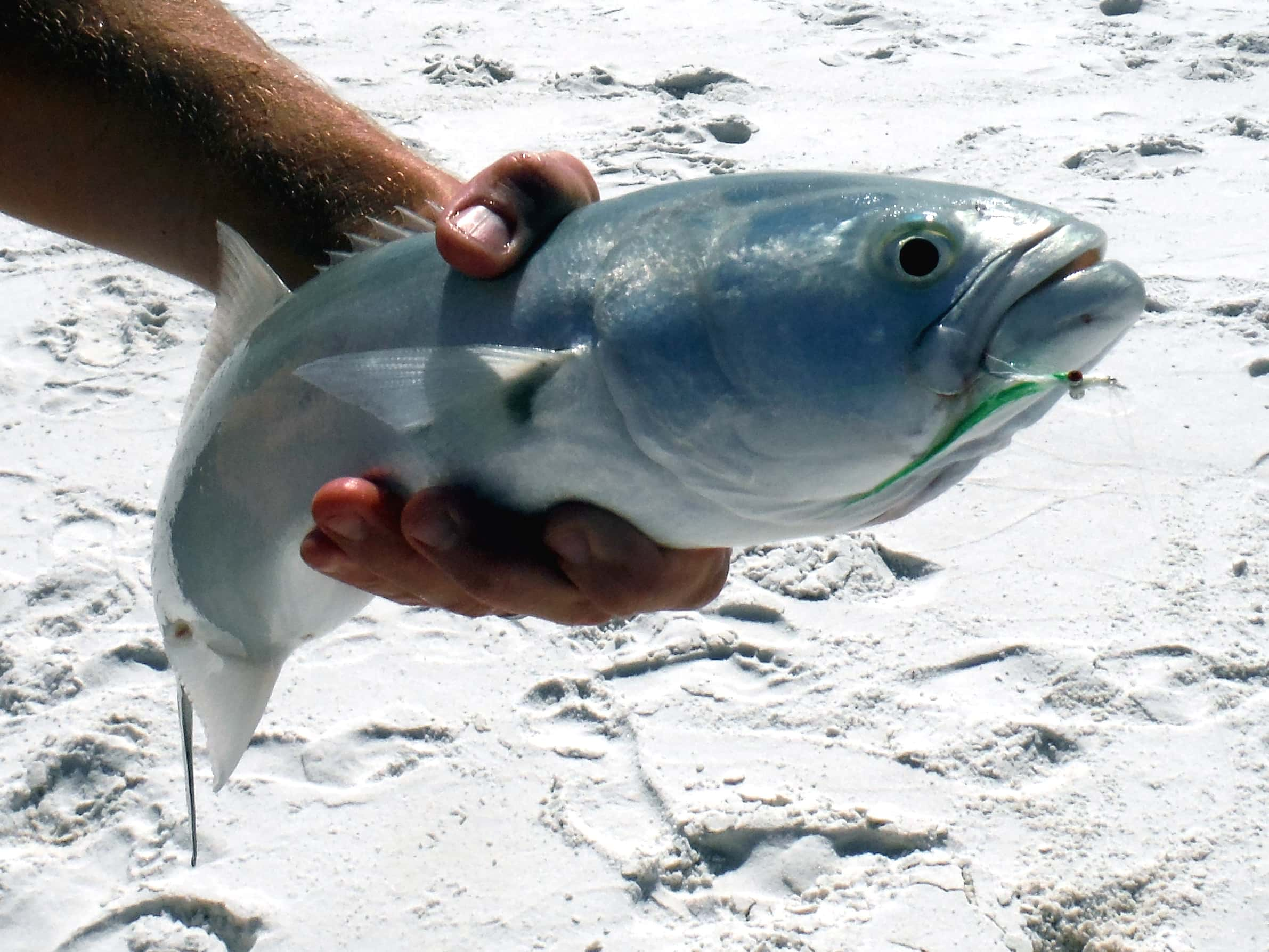
The author caught and released this nice bluefish on the fly rod after noticing an uptick in activity and applying proven tactics for predators learned on other waters. Simonson Photo
By Nick Simonson
The calm blue-green waters of the Gulf of Mexico shimmered under the sun as the first mullet flopped up and splashed back down on the late-morning surface. From my spot in the lounger underneath the multi-hued beach umbrella, I watched with interest as small baitfish in the shallows splashed the surface and the larger mullet kept up their graceless water ballet. Waiting for my family as I secured our beachhead on the white sand for the day, my fly rod and polarized sunglasses remained up at the resort, and I felt the phantom limb tingle of their distance as the water came alive in front of me. When the movement of fish suddenly shifted, I squinted against the shimmer as two or three purposeful slashes rose up behind the scattered emerald minnow-like prey.
Unable to resist the possibility that a predator – and potentially a catchable sportfish – was in the area, I stood up and began walking out toward the action as blade-shaped streaks far different from the lazy movements of the rounded mullet rose and cut the top of the water column and busted on the baitfish in front of me. Waist deep in the trough along the sandbar, I watched as a blue streak raced into the alewife school and picked off one of them from the very edge before sprinting back out into the deeper water. The completion of that particular circle of life instinctively sent me hurriedly high stepping through the shallows back to shore, across the warming white sands and up the brown wooden stairs to the condo. The elevator to the tenth floor never moved so slowly.
With fly rod in hand, I made my way back down and started my back cast as soon as the last beach walker cleared my area as I headed toward the school of jumping fish. There, mixed in with the mullet were more and more surface slashes. Some I could see from previous experience in the gulf waters were Spanish mackerel, but others that moved below the surface were unidentifiable shadows herding the schools of smaller fish against the rise in the shoreline bottom. I unfolded my first cast terminating in a green-and-white Clouser minnow and it splashed down over the darker blue water.
I barely had the chance to make my first strip and the line went taught and pulsed with the feel of a fish on the far end. For a couple of seconds, it was there until I detected a pop and the line went limp. Bringing it in, I felt the end of the 12-pound fluorocarbon tippet, and it was scraped to a point where it was cut clean off, a victim of the teeth of whatever it was out in the slightly rippled water. I regrouped under the rainbow umbrella, tying on a stretch of 20-pound fluorocarbon as a better bite leader and selected a chartreuse streamer of similar size. Headed back into the growing fray, I delivered a cast in the darker drop-off and felt the same bump that tightened the line as I hauled back in a sideways strip-set.
The line peeled off the reel to the point where I could see the bright green backing starting to show through the last of the white coils on the arbor. Back and forth we went as the fish stayed down along the bottom, taking a few turns of line before I regained them as I stepped closer to shore to leverage the skinny water of the shallows against my opponent. As the aquatic real estate dried up, the fish took to the air, clearing a solid foot above the surface and it’s silvery-blue rounded head and large eye triggered a run through my limited mental dossiers of saltwater species, but a shout from a nearby beachgoer confirmed it: “wow, that’s a nice bluefish for this area!”
I turned and smiled as I worked the last of its energy out in the remaining twelve inches of water and bent down to pick up the shimmering bluefish. The streamer had stuck perfectly in the corner of its toothy mouth, avoiding the fate of the previous pattern I had offered up. The saggy belly of the blue hung around my hand, while its bony head and jaws resisted the slight tweak of the pliers on shore. With a quick photo of my first one on the long rod, I turned it loose and watched it bulldog its way out across the sandbar and into the first trough beyond. The rest of the holiday afternoon under the warm subtropical sun would be spent chasing its brethren and the toothy mackerel that ran with them until the tide came up and the bite slowed down. Cutting the hairs from my bucktail streamers and slicing the foam of my surface poppers, the shallow water predators did a number on my fly box but served as an important reminder.
Ultimately, fish are fish everywhere. Big ones eat little ones, good conditions spur heightened activity and by paying attention to that chain and following the food, along with finding ways of using water to your advantage, tactics transferred from north to south can help you connect, no matter where you might find yourself…in our outdoors.

